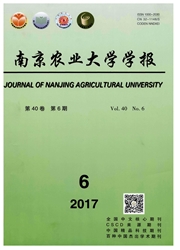

 中文摘要:
中文摘要:
为了探明同域棉蚜(Aphis gossypii Glover)种群的生态分化与进化程度,检测了室内长期筛选所得的迁飞型、滞留型、棉花型和瓜型棉蚜品系,以及在南京田间采集的棉花和黄瓜上的棉蚜,共84个样本的线粒体DNA COⅠ基因的部分序列。结果表明:南京地区寄主型和迁飞型棉蚜种群的COⅠ序列同源性很高,为99.8%~100%。在各样本的569 bp大小序列中检测到3个突变位点,共形成4种单倍型(H1~H4),其中2个突变发生在迁飞型中,另1个发生在滞留型中,而棉花型和瓜型棉蚜中没有检测到突变,各品系棉蚜还共享着同一单倍型H4。迁飞型棉蚜的单倍型多样性(h)最高,为0.68~0.75,滞留型为0~0.18,而棉花型和瓜型无多样性。各种群内核苷酸多样性(π)都极低。UPGMA聚类分析表明,迁飞型与其他各品系间的遗传距离相对较远。系统进化树显示,棉蚜种群正向着3个支系分化:支系一为COⅠ没有变异的棉花型、瓜型、滞留型和迁飞型个体所组成,数量占绝对优势;支系二和支系三仅由迁飞型组成,其COⅠ序列均发生了变异。迁飞型品系中存在突变位点的单倍型H3和没发生突变的H4,在平均寿命、净增殖率与内禀增长率上均没有显著差异,COⅠ序列在该位点上的变异还不足以影响迁飞型棉蚜的生态适合度。
 英文摘要:
英文摘要:
In order to illustrate the degree of ecological differentiation and evolution in Aphis gossypii population, portion of the cytochrome C oxidase subunit I gene ( CO I ) in mtDNA of 84 samples from migratory, sedentary, cotton- and cucurbits-specialized strains,and the natural population in cotton and cucumber fields in Nanjing,were examined. The results showed that the identity of CO I pairwise sequences was 99.8%-100% among these samples, and three mutations in CO I sequence were found in migratory and sedentary strains which resulted in 4 haplotypes( H1-H4). Two mutations were detected in the migratory strain,and one was found in the sedentary,while no mutation was detected in the cotton- and cucurbits-specialized strains. Notwithstanding, all the strains still shared haplotype H4. Haplotype diversity of the migratory strain was maximum( h =0.68-0.15 )followed by the sedentary(0- 0.18) ,and these of the cotton-and cucurbits-specialized strains were zero. The nucleotide diversity within all strains was very low. Cluster analysis by UPGMA showed that the migratory strain was relatively distant from the other three strains. Molecular phylogenetic analysis based on CO I gene showed that cotton aphid in Nanjing was evolving gradually for three clades. Clade 1 was dominant and no mutation in CO I sequnce, which was composed of the cotton- and cucurbits-specialized, migratory and sedentary strains. And the clade 2 and clade 3 were rare which contained only some migratory strain with mutations in CO I sequnce. There was no significant difference between haplotype H3 and H4 in net reproductive rate, average lifespan and innate increase rate, and the ecological fitness of migratory strain was not affected by the mutation in CO I sequence.
 同期刊论文项目
同期刊论文项目
 同项目期刊论文
同项目期刊论文
 期刊信息
期刊信息
